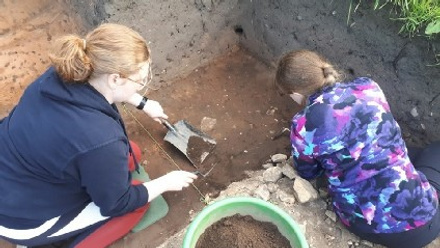Discover Neolithic archaeology in Ireland
Build your archaeological skills and help investigate the hidden world of Neolithic monuments that have recently been revealed by geophysical survey in the buffer zone surrounding the Brú na Bóinne UNESCO World Heritage Site
Group size: 25
Minumum age: 18
Minimum duration: One or two weeks
Content: Neolithic archaeology, funerary archaeology, archaeological practice in Ireland, field skills, excavation, survey, recording, photography, interpretation, finds identification, and illustration
Food, travel, and accommodation: Not included
Required experience: Basic understanding of core archaeological fieldwork principles (see Booking FAQs for details)
Highlights:
- Build your field skills with hands-on learning that puts you right at the heart of the archaeological action
- Contribute to internationally significant discoveries in one of the most famous Neolithic landscapes in the world
Neolithic archaeology in the Boyne Valley
The Boyne Valley, County Meath, is home to some of the best-preserved Neolithic sites in the world. Among the most famous is the World Heritage Site of Brú na Bóinne; a spectacular funerary landscape of standing stones, henges, and passage tombs dominated by the monuments of Newgrange, Knowth, and Dowth – situated on a bend in the north bank of the River Boyne.
At over 5,000 years old, these incredible structures contain the largest collection of megalithic art in Western Europe, and were clearly built with a sophisticated knowledge of science and astronomy.
So far, most archaeological investigation into the Boyne Valley’s prehistory has been tightly focussed on the monuments at the heart of this World Heritage Site.
But as archaeological awareness spreads out into the wider valley, including south of the river, a growing body of evidence is showing that these monuments did not stand in isolation; they are surrounded by a hidden world of buried monuments teeming with evidence of the people who built them.
In the last 10 years, large-scale geophysical research by University College Dublin (UCD) School of Archaeology and the Romano-Germanic Commission (RGK), Frankfurt, along with INSTAR-funded lidar, satellite, and palaeoenvironmental surveys of Brú na Bóinne, has a revealed a hidden landscape of henges, timber enclosures, ritual structures, palisades, and the remains of vast wooden monuments. Some of them are so large that they are estimated to have required 14,000 trees cut down to make.
The scale of these new discoveries is immense; and none of them have been excavated yet.
DigVentures is partnering with UCD School of Archaeology to conduct the first excavations of these new discoveries, and begin a new phase of archaeological investigation into the Boyne Valley – and you can be part of it.
A world-class fieldschool that's open to everyone
DigVentures is teaming up with University College Dublin (UCD) School of Archaeology to begin a new phase of archaeological investigation in the Boyne Valley.
To do it, we’ll be running a community fieldschool, open to anyone who wants to build their archaeological field skills, and contribute to world-class scientific research.
You’ll need a basic understanding of core archaeological fieldwork principles before you arrive (see Booking FAQs for details), but join us for a week and you’ll gain a solid introduction to Irish Neolithic archaeology, and the skills, techniques, and contextual understanding that go with it.
Join us for two weeks, and you’ll have extra time to try a wider range of archaeological techniques and consolidate your skills, so that you can walk away with the confidence to use them, wherever your archaeological journey takes you next.

